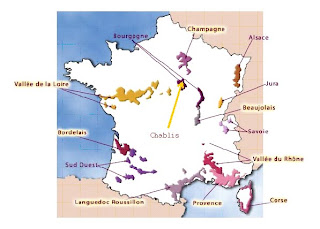 go, if you had asked me what Chablis was, I would very quickly define it as a giant jug of watery white wine with a screw cap. I would also tell you that, on nights we were feeling especially sophisticated, my college friends and I would depart from our usual Popov and cranberry (or Goldschlager if someone had procured a fraternity brother's leftovers), pour it into red Solo cups with an equal portion of Sprite, and drink it greedily down.
go, if you had asked me what Chablis was, I would very quickly define it as a giant jug of watery white wine with a screw cap. I would also tell you that, on nights we were feeling especially sophisticated, my college friends and I would depart from our usual Popov and cranberry (or Goldschlager if someone had procured a fraternity brother's leftovers), pour it into red Solo cups with an equal portion of Sprite, and drink it greedily down.Awesome.
I'm convinced that a ton of normal wine people share this experience. You may have a vague idea that Chablis is a French word, and may even know that the big jug brands ripped the name off a great wine region in France, but you may not. If you don't know about this stuff, you've got to get clued in because Chablis is a phenomenal, fabulous wine. If you're bored with your whites, it will give your mouth a thrill.

Chablis is actually a small, super-northern region of Burgundy (yes, a Chablis is a Burgundy. Hopefully that ratchets up it's rep a little). It's actually closer to Champagne than the main part of Burgundy. Any way you look at it, the area's got major street cred.
Like most French wines, it's named for the region. The grape: it's Chardonnay. BUT this is NOT your mother's big oaky butterball. This is something entirely different.
Chablis is grown on a chalky soil in this cold region. Most is not aged in new oak, so it has none of the caramel, vanilla, woody flavor that you may find in the Chardonnays you swore off (if you hate Chard, that is). These wines smell like crisp green apples and mountain streams, and have unbelievably high acidity. They can even taste a little salty or chalky because of the soil. If you like high acid wines, look no further. They are also such a great match with food -- especially with seafood which they complement, and cream sauces, which they cut through so your Alfredo sauce isn't like swallowing heavy cream.
With all that said, some producers do a different style that is not considered to be "classic." They use a bit of oak to soften the wine. I feel like this is a marketing ploy to try and compete with American wines. It's disappointing to me, but maybe I'm too much of a traditionalist.
We served Chablis at our wedding last year. We had a few bottles left over (these were not stolen by our caterer, which was the fate that befell the Cabernet and Pinot Noir...urgh) so we opened one last night. Here goes...
 The Wine: Louis Latour Chablis
The Wine: Louis Latour ChablisWhere It's From: Chablis, Burgundy (wine geeks -- appellation is Chablis Controlee)
The Grape: Chardonnay
Vintage: 2006
Price: $17.99
Color: It was a light color, like hay. That's usually what Chablis looks like. This one, though, had some yellow undertones. That made me wonder if it was age (whites darken as they age -- like age spots on people) or oak (also makes a white wine more yellow).
Smell: One little whiff and the butterscotch and caramel shot up the beak. Disappointing. There was green pear and maybe some Asian pear (which I like to call a 'papple' because it's a pear-apple), white flower, and honeysuckle. Although I did smell mineral, stream bed, and chlorine the main vanilla-romas tipped me off to the fact that Latour had dumbed down this wine to give it broader appeal. They oak aged it a little. I have such high regard for them (their higher tiers are phenomenal) that this made me sad.
Taste: Kind of like a Macintosh apple, or a caramel candied apple, the Latour was round and even had pineapple notes, which I'd expect in a fuller style from further south in Burgundy or in other parts of the world. I wouldn't pick this out of a line up as a Chablis, but it did have a metallic quality and some kinetic lemon zest flavors. The best part of the wine was a classic Chablis character -- rock solid acidity. That said, the overall impression was a rounder, medium-bodied, red-appley wine rather than an austere, granny smith apple, mineral rock, acid bowl.

Food: Because the oak is present but not overpowering, it's a good food wine. I'd try it with some grilled halibut or grilled chicken. Actually, if you need to bring a wine for Thanksgiving, this may be a good bet too. It's versatility will pair well with the mashed potatoes, the string beans, the toasted chestnuts, and, most importantly, the turkey.
Drink or Down the Sink?: Drink. Here's a winter white for you. Although it did not resemble all that I love in Chablis, the wine is a good winter sipper. Like a previous post recommends -- leave it out of the fridge for a bit and sip away. Although I really recommend trying a more classic Chablis (William Fevre Champs Royaux is classic and the same price, or get higher tiers of Latour, which are terrific) this is a very versatile wine and a good compromise if you don't like a big wine and your friend/spouse/partner/drinking buddy/dog does.
Readmore »»

















